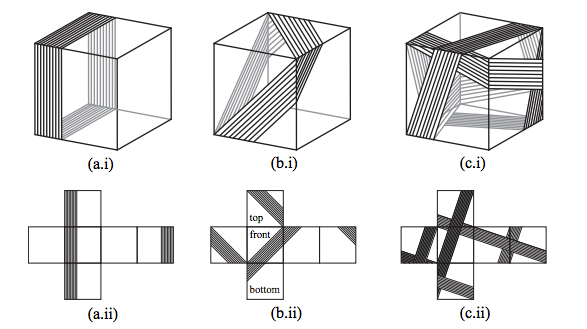I'm not sure about the corners, but the discrete analogue of geodesic for a convex polyhedron is a sort of Snell's law, the angle approaching an edge must equal the angle of the string leaving the edge. Consider that the string has no idea it is in three dimensions, so if you cut out those two adjacent faces and fold them flat, you see that the path of the string can be shortened unless it is a straight line in the flat unfolded plane.
Note that when you fold it back up, this condition may be tricky to interpret.
Well, that's a start. Maybe they say it in one of your articles.
Yes, in your illustration c(ii), different choices of how to unfold the cube might make it possible to show one of the bands in full length as a bunch of parallel straight lines. Worth trying to draw that, label the faces and edges and all and see how well that goes. I'm not saying some arbitrarily complicated polyhedron can be unfolded in such a fortunate way.
Alright, I misunderstood the illustration a bit, (c.ii) is a single band of strings. So there is no way to unfold the cube to get everything resembling straight lines. Meanwhile, I think the rule for corners should begin with this: no string is permitted to go along an edge. There must be a way to decide, essentially by continuity, which polygon comes next. Need to think about other ways to say that...For the cube, it is impossible to implement this rule. Any string hitting a vertex, in the unfolded triple of squares, has only open air ahead of it, so the choice of where to go next in the cube is arbitrary and physically unstable. Not looking good for head on collision with a vertex.
EDITTTTT: It seems Misha wins. I did a little experiment with a regular (pentagonal) dodecahedron. Given a short segment that passes through a vertex and is orthogonal to the joint edge of two neighboring faces, and is given equal length on both faces, it is still shorter to slip the string off the vertex and take the "geodesic" that passes through the third pentagon at that vertex. So my one scheme, involving large angles, is still hopeless.

